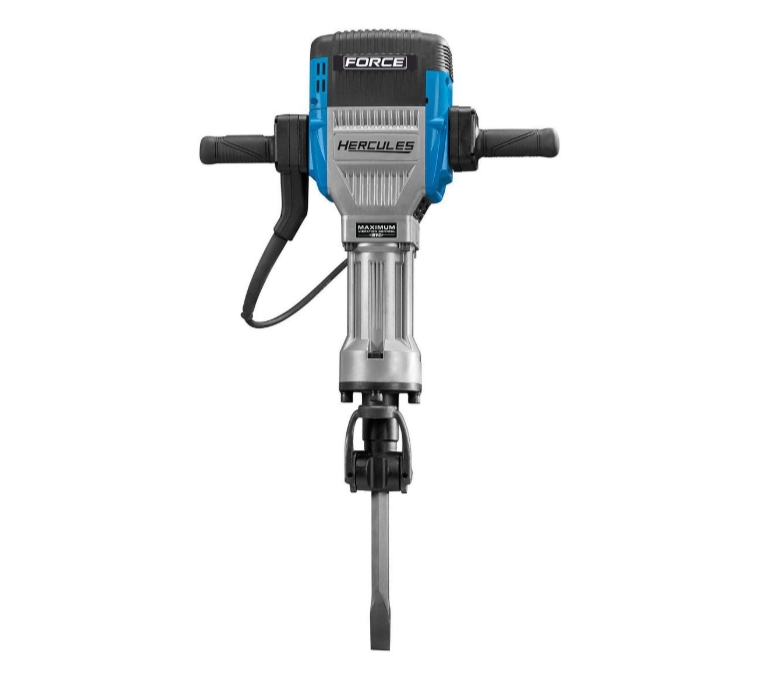
HERCULES 15 Amp 66 Lb. 1-1/8 in. Hex Breaker Hammer with Maximum Vibration Control
- Tackle the toughest jobs with the HERCULES® Force 1-1/8 in. Hex Breaker Hammer. This breaker hammer is built to last, with a super-strong transmission and a hardened gear set. Concrete is no match for the powerful 58 Joules of striking power delivered at an impressive 1000 BPM. This powerful breaker hammer has a universal 1-1/8 in. hex retainer that can be used with collared or non-collared bits to maximize performance. Anti-vibration technology delivers hours of hard use with minimal fatigue.
- Maximum Vibration Control – Reduces vibration felt by user at the handles
- 15 amp motor delivers 58 Joules of striking power delivered at 1000 BPM
- Service Minder Maintenance System – Shuts down tool when brushes are in need of replacement
- Impact resistant housing protects tool against drops and bumps on the jobsite
- 1-1/8 in. hex retainer supports a wide variety of collared and non-collared bits for any job
- State-of-the-art transmission case with hardened gears and ball bearings for superior durability and service life
$649.99
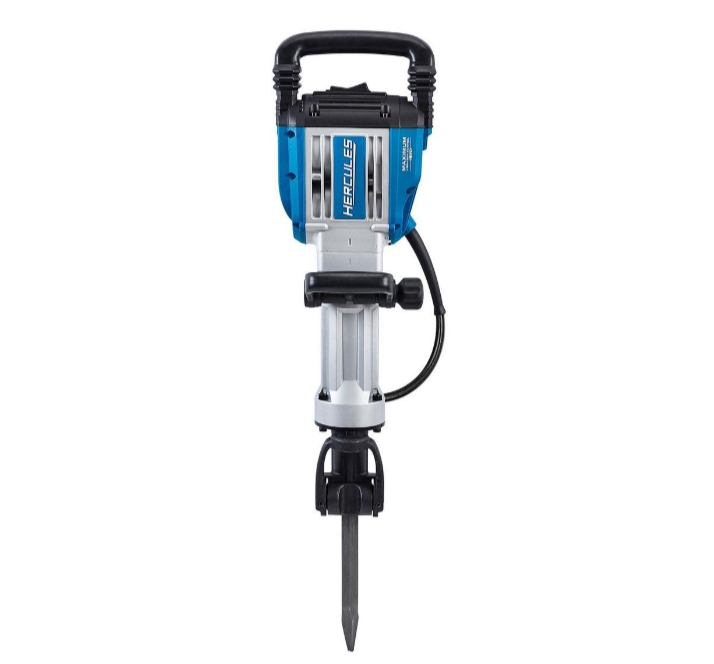
HERCULES 15 Amp 42 lb. 1-1/8 in. Hex Lower Wall Breaker Hammer with Maximum Vibration Control
- This powerful HERCULES® 15 Amp 42 lb. 1-1/8 in. Hex Breaker Hammer with Maximum Vibration Control delivers over 22 ft. lbs. of impact energy to break up the hardest surfaces. This powerful breaker hammer has a universal 1-1/8 in. hex retainer that can be used with collared or non-collared bits to maximize performance. Anti-vibration technology delivers hours of hard use with minimal fatigue.
- 20% faster striking*, the 15 Amp motor delivers 22 ft. lbs. of breaking force at 1700 BPM
- 1-1/8 in. hex retainer supports a wide variety of collared and non-collared bits for any job
- State-of-the-art transmission case with hardened gears and ball bearings for superior durability and service life
- Maximum Vibration Control reduces vibration felt by user at the handles
- In-line design provides balance for ultimate control no matter the angle
- Grease-packed gear box for smooth operation and maximum tool life
- Adjustable 360° side handle for maximum comfort and control
- Rugged cast aluminum motor housing for high strength and lighter weight
- High-impact resistant housing protects tool against drops and bumps on the jobsite
$499.99
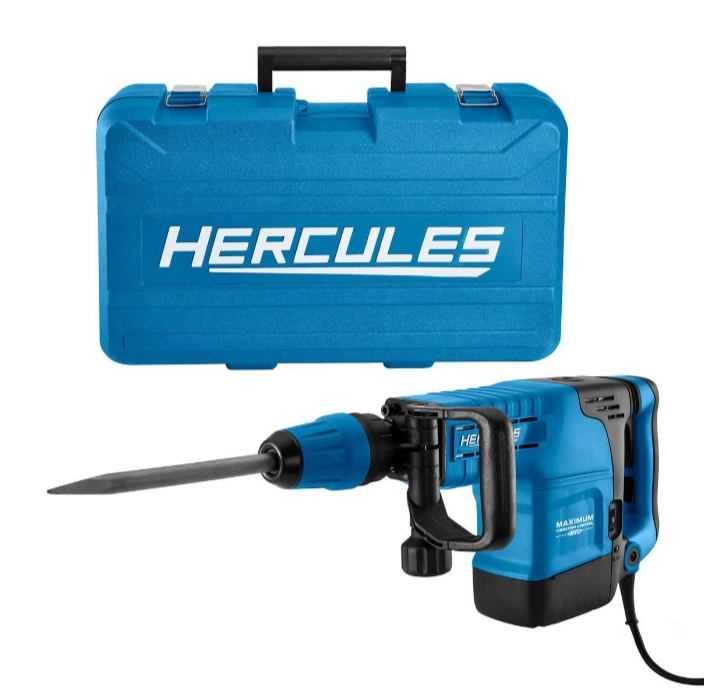
HERCULES 14.5 Amp 23 lb. SDS-MAX Type Demolition Hammer with Maximum Vibration Control
- The HERCULES® 23 Lb. SDS-MAX Type Demolition Hammer is equipped with a high performance heavy duty motor that is jobsite ready. The quick-release chuck makes on-the-job bit changes easy, reducing downtime. An electronically controlled motor provides constant power under load to keep the hammer at top performance during heavy demo applications. The shock absorbent anti-vibration handle provides maximum vibration control and reduces user fatigue. Included with the tool is a jobsite tough heavy duty storage case.
- 14.5 amp motor delivers 1900 BPM of striking power
- Heavy duty hardened gears with grease-packed gearbox for superior life and durability to withstand tough jobsite conditions
- Variable speed control dial accurately matches speed to application
- SDS Max type chuck provides ultimate bit retention and handles the toughest applications
- Adjustable 360° auxiliary handle for maximum comfort and control
- Rugged jobsite tough case provides secure storage tool and accessories
$379.99
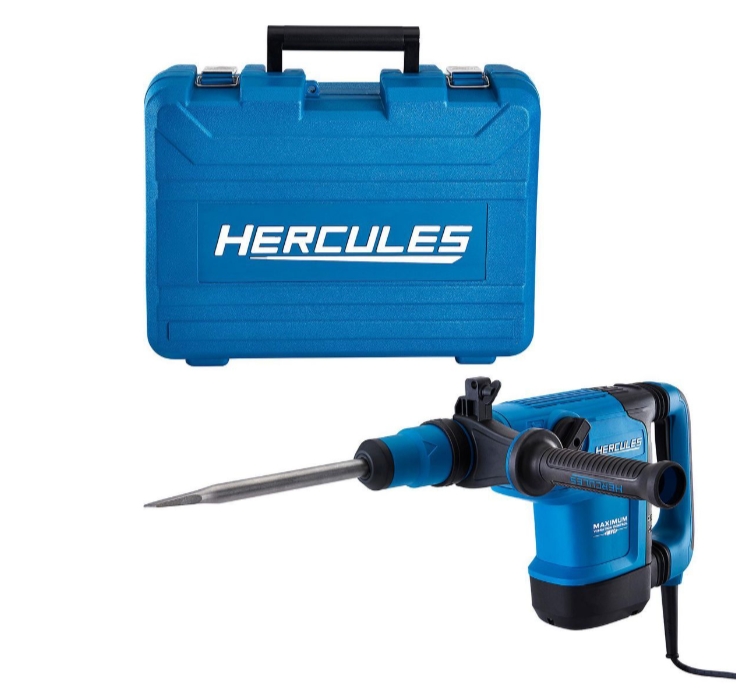
HERCULES 12 Amp 1-9/16 in. SDS-MAX Type Variable-Speed Rotary Hammer with Maximum Vibration Control
- Tackle the toughest jobs with the HERCULES® 12 Amp 1-9/16 in. SDS Max-Type Variable Speed Rotary Hammer. Equipped with a high-performance heavy duty hammer and a grease packed gear box with hardened gears for superior life and durability, this tool is capable of withstanding the toughest jobsite conditions. Anti-vibration technology delivers hours of hard use with minimal fatigue. The convenient selector knob switches between rotary hammer, and hammer only. The electronically-controlled motor maintains constant power under load to keep the hammer at top performance during heavy demo applications.
- 12 Amp motor delivers 0-2950 BPM of striking power
- Electronically-controlled motor maintains constant speed under load
- Quick-release chuck for effortless bit replacement
- Adjustable 360° side handle for maximum comfort and control
- Shock absorbent anti-vibration handle prevents strain and fatigue
- Rugged blow mold case provides secure storage for tool, oil, and chisel
- Service indicator light identifies when maintanance is required
- Easily switch from rotary hammer to hammer-only function
$229.99
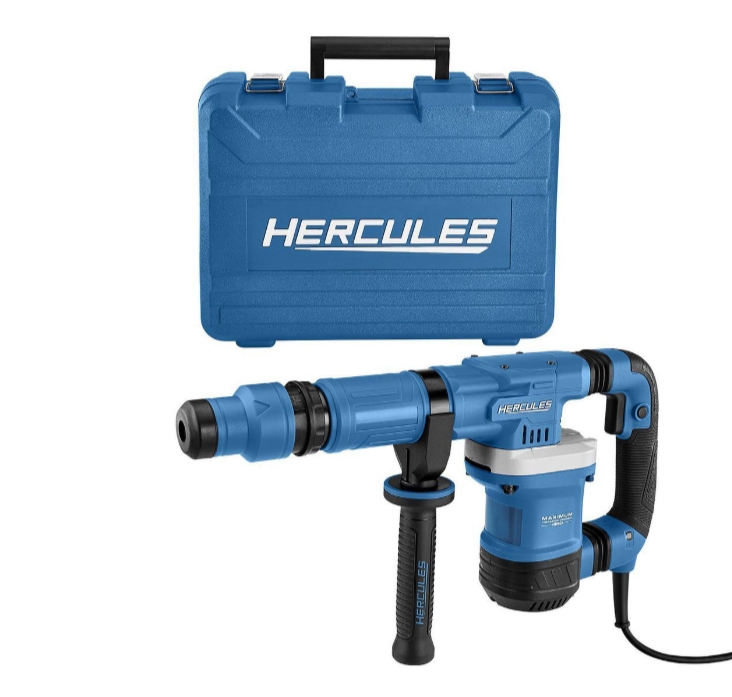
HERCULES 10 Amp 12 lb. SDS-MAX Type Demolition Hammer with Maximum Vibration Control
- Tackle the toughest jobs with the HERCULES® 12 Lb. SDS-MAX Type Demo Hammer. Equipped with a high-performance heavy duty hammer and a grease-packed gear box with hardened gears for superior life and durability, this tool is capable of withstanding the toughest jobsite conditions. Anti-vibration technology delivers hours of hard use with minimal fatigue. The quick-release chuck makes on-the-job bit changes easy and cuts downtime. Concrete is no match for the constant striking power of this hammer delivered at an impressive 3800 BPM.
- 10 Amp motor delivers 3800 BPM of striking power
- SDS-MAX type chuck provides ultimate bit retention
- Adjustable 360° auxiliary handle for maximum comfort and control
- Shock absorbent anti-vibration handle prevents strain and fatigue
- Rugged blow mold case provides secure storage for tool and oil.
$249.99
When I first laid eyes on a Hercules Hammer at my buddy’s construction site, I knew my toolkit was missing something special. There’s something almost mythical about holding a tool that lives up to its name – and after spending two years putting various models through their paces, I’m ready to share everything I’ve learned. Whether you’re a professional contractor, a serious DIYer, or someone looking to invest in a tool that will outlast most relationships, this guide will help you navigate the world of what I’ve come to believe is the most versatile demolition tool on the market today.
What Exactly Is a Hercules Hammer?
Before diving into the nitty-gritty details, let’s clarify what sets a Hercules Hammer apart. Unlike your standard claw hammer that’s primarily designed for driving and removing nails, the Hercules Hammer is a heavyweight champion built for serious destruction and construction alike.
The first time I swung one, the difference was immediately apparent. The substantial weight, the perfect balance, and the raw power it delivered made my regular hammer feel like a toy. It’s essentially a high-performance demolition hammer with specialized features that make it suitable for everything from delicate trim work to tearing down walls.
What initially drew me to the Hercules line was their reputation for durability. In my experience, they truly live up to the hype. I’ve used mine to demolish concrete, break through stubborn materials, and even as a makeshift anvil in a pinch. Two years in, and it still looks nearly as good as the day I bought it.
The Key Features That Make Hercules Hammers Stand Out
After comparing numerous brands and models, I’ve identified several standout features that have made the Hercules my go-to choice:
Superior Weight Distribution
The engineers behind the Hercules Hammer clearly understand physics. The weight distribution is nothing short of perfect, concentrating mass at the strike point while maintaining balance. This means you get maximum impact force with minimum user fatigue – something I deeply appreciate during long workdays.
When I switched from my old Stanley to my first Hercules, I noticed I could work nearly twice as long before my arm started complaining. The science here is simple but effective: a well-balanced hammer requires less muscle effort to control, letting you work longer and more precisely.
Durability Beyond Compare
My grandfather always said, “Buy once, cry once,” and that philosophy applies perfectly to the Hercules Hammer. Made from forged, heat-treated steel, these hammers are built to withstand abuse that would destroy lesser tools.
The head is particularly impressive – after countless strikes against concrete, metal, and hardwood, mine shows minimal wear. The striking face maintains its shape without mushrooming, and the claw still grips nails firmly. In comparison, I’ve gone through three budget hammers in the same timeframe I’ve owned my primary Hercules.
Shock Absorption Technology
One feature I didn’t fully appreciate until I started using the Hercules regularly was its vibration dampening. The proprietary handle design incorporates multiple shock-absorbing zones that significantly reduce the vibration transferred to your arm.
This might sound like marketing speak, but the difference is tangible. After a full day breaking up old tile with my Hercules, I noticed substantially less hand fatigue and none of the tingling sensation I used to experience with my previous hammers. For professionals who use these tools daily, this feature alone can be career-extending.
Ergonomic Handle Design
The handle design deserves special mention. Covered in a textured, high-density rubber composite, it provides exceptional grip even when wet or covered in dust. The contoured shape fits naturally in my hand, with subtle finger grooves that seem to adapt to different grip styles.
What impresses me most is how this ergonomic design translates to precision. Whether I’m delicately tapping finish nails or swinging with full force during demolition, the control remains consistent. This versatility has made my Hercules the first tool I reach for in a surprising variety of situations.
Types of Hercules Hammers Available
Through my extensive research and personal experience, I’ve found that the Hercules line offers impressive variety. Here’s a breakdown of the main types:
The Classic Demolition Hammer
The flagship model weighs in at around 22 ounces and features the traditional claw design, though significantly reinforced. This is the all-arounder that sits prominently in my tool belt. It’s heavy enough for serious work but not so weighty that it becomes cumbersome during extended use.
The striking face is slightly convex, which I’ve found helps prevent glancing blows, while the claw has a steeper curve than standard hammers, giving it tremendous leverage for nail removal. After using this model to strip an entire deck, I became a convert.
The Sledge Model
When I needed to break up an old concrete patio, I invested in the Hercules Sledge. At 10 pounds, it’s a beast, but the dual-material handle made it manageable even for extended sessions. The head has a broader striking surface than traditional sledgehammers, distributing force more efficiently across whatever you’re demolishing.
What surprised me was how well-balanced it felt despite its weight. Many sledgehammers feel awkward and unwieldy, but the Hercules version somehow manages to feel natural in motion. It’s definitely not an everyday tool, but for serious demolition, it’s unmatched.
The Framing Specialist
The 28-ounce framing model has become my constant companion for construction projects. With a straight claw designed specifically for pulling large nails and separating lumber, it’s the ideal balance of weight and functionality for framing work.
The milled face provides excellent grip on nail heads, reducing the likelihood of glancing blows – a feature I particularly appreciate when working on elevated surfaces where every strike needs to count. I’ve found it significantly speeds up framing tasks compared to lighter hammers.
The Finishing Model
At the lighter end of the spectrum, the 16-ounce finishing hammer is the precision instrument of the Hercules family. I was initially skeptical about whether a “light” Hercules would maintain the quality of its heavier siblings, but it’s proven ideal for trim work, furniture assembly, and other detail-oriented tasks.
The reduced weight doesn’t mean reduced quality – it features the same premium materials and shock absorption as the larger models, just in a more nimble package. The smooth face prevents marring on finished surfaces, a detail I’ve come to appreciate during interior work.
The Multi-Tool Variant
Perhaps the most innovative offering is the Hercules Multi-Tool, which combines a hammer with specialized features like a pry bar, nail puller, and even a basic screwdriver function. While I was concerned this might be a gimmicky jack-of-all-trades-master-of-none, it’s actually become my favorite tool for renovation projects.
The ability to switch between hammering, prying, and pulling without changing tools has saved me countless trips back to the toolbox. It weighs slightly more than the classic model at 24 ounces, but the versatility more than compensates for the extra weight.
Hercules vs. Other Premium Brands
I’ve owned hammers from Stanley, Estwing, Martinez, and Stiletto, giving me a solid foundation for comparison. Here’s how Hercules stacks up against these industry standards:
Hercules vs. Estwing
Estwing has long been my benchmark for quality hammers, and I still keep my trusty blue-handled model in my backup toolkit. Both brands emphasize one-piece construction for durability, but Hercules edges ahead in comfort during extended use.
Where Estwing transmits slightly more vibration through its metal handle (even with the shock reduction grip), the Hercules composite handle system truly excels at dampening impact forces. However, I’d give Estwing the edge on pure aesthetic appeal – there’s something classically beautiful about their design that Hercules hasn’t quite matched.
Hercules vs. Martinez
Martinez hammers are the Ferrari of the hammer world, with prices to match. Having borrowed a colleague’s Martinez for a week, I can attest to their exceptional quality and innovative replaceable head system.
However, dollar for dollar, the Hercules delivers approximately 90% of the performance at roughly 60% of the cost. The Martinez might have a slight edge in weight-to-strength ratio and its modular design, but for most professionals and serious DIYers, the Hercules represents better value without significant compromise.
Hercules vs. Stiletto
Stiletto’s titanium hammers have developed an almost cult-like following among framers, and for good reason. They’re incredibly light while delivering force comparable to much heavier steel hammers.
Where Hercules wins is in versatility and durability. While the Stiletto excels at specific framing tasks, I’ve found the Hercules models better suited to multi-purpose use. Additionally, the softer titanium of the Stiletto shows wear faster than the hardened steel of the Hercules, especially when used on harder materials like concrete or stone.
Hercules vs. Stanley FatMax
The Stanley FatMax line represents the budget-friendly option in this comparison. Having used their hammers extensively before upgrading, I can say the Hercules justifies its higher price point through noticeably superior balance, durability, and shock absorption.
After six months of regular use, my FatMax showed significant wear on the striking face and the handle connection began to develop play. In contrast, my heavily-used Hercules still performs like new after two years. For occasional use, the FatMax is adequate, but for those who rely on their tools regularly, the Hercules investment pays dividends.
Suitability for Heavy-Duty Construction Work
Having employed my Hercules hammers on everything from backyard decks to commercial renovation projects, I can confidently say they’re more than capable of handling heavy-duty construction work. In fact, that’s where they truly shine.
The framing model has been my constant companion through building two complete room additions, where its weight and balance made driving large framing nails less of a chore. The demolition model made short work of removing old plaster walls in a century home renovation.
What separates Hercules from lighter-duty tools is their longevity under punishing conditions. Working alongside various crews, I’ve watched as budget hammers failed while my Hercules kept performing. The forged, one-piece construction virtually eliminates the most common failure point – the head separating from the handle.
For commercial crews working daily in demanding conditions, the additional investment in Hercules tools typically pays for itself within a single large project through improved efficiency and reduced replacement costs.
Price Points and Value Proposition
Let’s talk dollars and sense. Hercules hammers aren’t budget tools, with prices ranging from around $60 for the finishing model to approximately $120 for the sledge and specialty variants.
This positions them in the mid-to-high range of professional hammers – more expensive than Stanley or Dewalt offerings but more affordable than boutique brands like Martinez or Stiletto. After extensive use, I consider this pricing fair for the quality delivered.
The value proposition becomes clearer when you consider longevity. I’ve replaced numerous $25-$30 hammers over the years as they developed loose heads, damaged claws, or worn striking faces. My Hercules collection, despite heavier use, remains in excellent condition. This “buy once, cry once” approach ultimately saves money while providing a superior working experience.
For professionals who depend on their tools daily, the premium is easily justified through increased productivity and reduced downtime. For serious DIYers undertaking major projects, the investment spreads across numerous jobs, making the per-project cost quite reasonable.
Where to Purchase Hercules Hammers
Finding Hercules tools requires a bit more effort than picking up a hammer at your local big-box store, but several reliable sources exist:
Specialty Tool Retailers
My first Hercules came from a local contractor supply house that specializes in premium tools. These specialty retailers often have display models you can handle before purchasing – an advantage I highly recommend taking advantage of, as the feel of these hammers is something that needs to be experienced firsthand.
Online Marketplaces
Most of my subsequent Hercules purchases came through established online tool retailers. The manufacturer maintains an authorized dealer network to ensure authenticity – an important consideration as the brand’s popularity has unfortunately led to counterfeits appearing on some marketplace platforms.
Direct from Manufacturer
For the full range of options and occasional promotions, the manufacturer’s website offers the most comprehensive selection. They frequently run professional discounts and bundle deals that can make expanding your collection more affordable.
Professional Supply Catalogs
Many construction supply companies that cater to professionals carry the Hercules line in their catalogs. These can be good sources for bulk purchases if you’re outfitting a crew.
Regardless of where you purchase, I strongly recommend verifying the warranty registration process. Authentic Hercules tools come with impressive warranty coverage, but this requires proper registration.
Weight Considerations: Finding Your Perfect Match
The weight of your hammer significantly impacts both performance and user experience. After trying various models, I’ve developed some guidelines for selecting the appropriate weight for different applications:
16-Ounce Finishing Hammer
Ideal for: Trim work, cabinet installation, furniture assembly, and detail-oriented tasks.
The lightest Hercules option prioritizes precision and control over raw power. I’ve found it perfect for situations where too much force would damage materials. Despite its lighter weight, it still delivers more authority than comparable finishing hammers from other brands due to its excellent balance.
22-Ounce All-Purpose Hammer
Ideal for: General construction, home renovations, and mixed-use scenarios.
This is my daily driver and the model I recommend for most users. It balances power and maneuverability, making it versatile enough for everything from hanging pictures to light demolition. The weight provides sufficient force for most tasks without causing undue fatigue during extended use.
28-Ounce Framing Hammer
Ideal for: Framing, heavy construction, and situations requiring maximum driving force.
When building my workshop, this heavier model proved invaluable for driving large framing nails efficiently. The additional weight means fewer strikes required, saving time and effort across large projects. However, the trade-off is increased arm fatigue during extended sessions, making it less ideal for general use.
10-Pound Sledge Hammer
Ideal for: Demolition, breaking concrete, and heavy material removal.
This specialist tool serves a specific purpose and does it exceptionally well. The substantial weight concentrates tremendous force on the target, making previously daunting demolition tasks manageable. However, it’s definitely not an all-day tool for most users – even with the excellent handle design, physics eventually takes its toll on your muscles.
My recommendation for most serious DIYers would be to start with the 22-ounce model, which handles roughly 80% of common tasks effectively. Professionals might consider beginning with both the 22-ounce all-purpose and the 28-ounce framing model to cover a wider range of applications.
Ergonomics: The Secret to All-Day Comfort
The handle design of Hercules hammers represents a significant advancement over traditional tools, incorporating several ergonomic features that reduce strain during extended use:
Contoured Grip
The subtle contouring of the handle provides natural finger positioning, reducing grip pressure needed to maintain control. I’ve found this particularly beneficial during precise work, where a relaxed grip improves accuracy.
Anti-Vibration Technology
The proprietary composite material in the handle incorporates microscopic air pockets that absorb shock waves before they reach your hand. This might sound like marketing hype, but the difference is immediately noticeable when compared to solid wood or metal handles.
Surface Texture
The slightly textured surface provides secure grip without the extreme tackiness that collects dirt and becomes uncomfortable over time. Even when my hands are sweaty or dusty, the hammer remains controllable without requiring a death grip.
Weight Distribution
Perhaps most importantly, the weight is balanced to create a natural pendulum action that maximizes force delivery while minimizing effort. This means each swing accomplishes more work with less exertion, the holy grail of tool design.
For those with wrist or elbow issues from years of using traditional tools, the ergonomic benefits alone can justify the switch to Hercules. I’ve heard from several veteran carpenters who extended their careers by years after transitioning to tools with similar ergonomic features.
Materials and Construction Quality
The exceptional performance of Hercules hammers stems directly from their premium materials and construction methods:
Head Material
The striking heads are forged from high-carbon steel, heat-treated to achieve the optimal balance of hardness and toughness. This prevents both premature wear and the brittle fracturing that can occur with improperly tempered steel.
I’ve examined the microscopic structure of the metal (a friend works in metallurgical testing), and the consistent grain pattern speaks to the quality of the forging process. This translates to real-world durability that’s immediately apparent in use.
Handle Composition
The handles utilize a multi-material approach, with a rigid fiberglass core providing structural strength while the outer composite layer delivers comfort and shock absorption. This hybrid construction outperforms both traditional wood and single-material synthetic handles.
One-Piece Design
Many premium models feature one-piece construction, eliminating the handle-to-head connection that represents the failure point in most hammers. For those models with separate components, the connection method uses advanced bonding techniques and mechanical reinforcement to ensure longevity.
Protective Coatings
The striking surfaces feature a proprietary treatment that increases surface hardness while the remainder of the head has a corrosion-resistant coating. This attention to detail prevents the two most common forms of degradation – deformation of the striking face and rust in the claw area.
In my experience, these material choices directly translate to performance advantages in the field. The heads retain their shape even after thousands of impacts, the handles remain comfortable during extended use, and the entire tool maintains its original balance and feel over years of service.
Effective Usage Techniques
Owning a premium tool only delivers value when used correctly. Here are techniques I’ve developed to maximize the effectiveness of Hercules hammers:
Proper Grip Positioning
Unlike budget hammers that perform best with a choked-up grip near the head, Hercules models are balanced for optimal performance when gripped at the intended position near the end of the handle. This provides maximum leverage and swing speed while maintaining control.
I typically position my hand about 1-2 inches from the end for general use, moving slightly closer to the head for precision work. This leverages the hammer’s balanced design to deliver maximum force with minimum effort.
Swing Mechanics
The balanced weight distribution enables a more fluid swing motion that generates force through acceleration rather than muscle power. I’ve found a relaxed grip combined with proper body positioning delivers better results than white-knuckling the handle.
Allow the hammer to do the work – start the swing with your shoulder and elbow, then let momentum carry through to impact. This technique prevents fatigue and improves accuracy across repeated strikes.
Material-Specific Approaches
Different materials require adjusted techniques. For hardwood, I use shorter, more controlled swings to prevent splitting. For masonry, I employ full swings with follow-through to maximize impact force. For delicate materials, I choke up on the handle slightly and use wrist action for precision.
The versatility of Hercules hammers accommodates these varied approaches better than specialized tools, making technique adaptation more important than tool switching in many cases.
Nail Set Technique
When driving nails, I’ve found the slightly convex face of most Hercules models reduces the chance of bending nails if you strike with the center of the face. Start with lighter taps to set the nail, then increase force progressively for efficient driving.
Applications Beyond Traditional Hammering
The versatility of these tools extends well beyond driving nails. Here are some alternative applications where I’ve found Hercules hammers particularly effective:
Controlled Demolition
The balanced weight and durable construction make these ideal for selective demolition work. When removing specific components without damaging surrounding materials, the control afforded by a quality hammer is invaluable.
I’ve used mine to carefully remove tile without damaging the underlying backer board, extract trim without marring adjacent surfaces, and even perform detailed plaster removal around historical features.
Improvised Anvil
The hardened steel head provides an excellent striking surface when you need to reshape metal components. I’ve used the flat side of my hammer head to straighten bent brackets, form custom hardware, and even shape ornamental metal elements.
Tamping and Compaction
For small-scale tamping tasks like setting fence posts or compacting soil in planters, the substantial weight concentrated in a relatively small area works remarkably well. The comfortable handle makes repeated tamping motions less fatiguing than with specialized tamping tools.
Ice Breaking
During winter months, the demolition model has proven surprisingly effective for breaking up ice on walkways and driveways. The controlled force delivery allows you to break the ice without damaging the underlying surface.
Persuasion Tool
Perhaps the most frequent “alternative” use is as a persuasion tool for components that need convincing to fit properly. Whether it’s tapping cabinets into alignment, persuading stubborn joints to seat fully, or encouraging recalcitrant parts to cooperate, a controlled tap from a quality hammer often succeeds where other methods fail.
Long-Term Durability Assessment
After more than two years of regular use across various projects, I can provide insight into the long-term durability of these tools:
Wear Patterns
The striking face of my most-used model shows minimal mushrooming or deformation despite thousands of impacts against various materials including hardened nails, concrete, and stone. The slight patina that has developed actually improves grip on nail heads compared to the original finish.
Handle Condition
The handle composite has maintained its tactile properties without degradation. Unlike rubber grips that can become sticky or rigid over time, the Hercules material has aged gracefully, maintaining its shock-absorbing properties while developing a personalized feel.
Functional Integrity
Most importantly, the functional characteristics remain unchanged. The head is as firmly attached as the day I purchased it, the claw retains its original geometry for effective nail pulling, and the overall balance feels identical to when new.
Aesthetic Changes
The only significant change is cosmetic – the original glossy finish has developed a worker’s patina that, in my opinion, enhances rather than detracts from the appearance. These tools age like quality leather, developing character without losing functionality.
Based on current condition and wear patterns, I estimate these tools have at least another decade of professional use before requiring replacement – an impressive return on investment compared to budget alternatives that might last a year or two under similar conditions.
Warranty Coverage and Customer Support
A premium tool should come with premium support, and Hercules generally delivers in this regard:
Limited Lifetime Warranty
Most Hercules hammers come with a limited lifetime warranty against manufacturing defects, covering the structural integrity of the tool under normal use conditions. This excludes cosmetic wear and damage from misuse, which is standard for the industry.
Registration Requirement
One important note: warranty coverage typically requires registration within a specific timeframe after purchase. I learned this the hard way with my first purchase, nearly missing the registration window. The process is straightforward through their website, but easily overlooked when you’re eager to put your new tool to work.
Replacement Experience
A colleague had to utilize the warranty service when his framing hammer developed an unusual defect – the claw portion developed a hairline crack despite normal use. The replacement process was straightforward but not particularly fast, taking about three weeks from claim submission to receiving the replacement.
Customer Service Interaction
My own interactions with customer service have been limited to technical questions, but I found the representatives knowledgeable about specific models and applications. They were particularly helpful in recommending the appropriate weight for specific tasks when I was expanding my collection.
Size Options and Selection Guidance
Beyond weight variations, Hercules offers size options that accommodate different users and applications:
Handle Length Variations
Standard models typically feature 16-inch handles, but select variants offer both shorter (14-inch) and extended (18-inch) options. The longer handles provide increased leverage and striking force at the cost of precision, while shorter versions offer better control in confined spaces.
Head Size Differences
Even within the same weight class, variations in head dimensions affect performance characteristics. Broader-faced models distribute impact force across a wider area – ideal for demolition but less precise for nail driving. Narrower faces concentrate force more effectively for driving fasteners but require greater accuracy.
Specialized Geometry
Some models feature specialized head geometry for specific applications – broad, flat surfaces for tamping, wedge-shaped profiles for splitting, or extended claws for improved leverage when removing fasteners.
Selection Recommendations
For most users, I recommend starting with a standard 16-inch handle in your preferred weight class. This provides the most versatile foundation around which to build a more specialized collection as your needs evolve.
Professionals might consider the “matched pair” approach – a general-purpose model for daily carry complemented by a task-specific variant for your most common specialty work. This combination addresses roughly 95% of typical requirements without excessive tool switching.
Demolition Capabilities and Limitations
The “Hercules” name sets expectations for destructive capability, and these tools largely deliver – with some important caveats:
Appropriate Demolition Applications
These hammers excel at controlled residential demolition tasks – removing drywall, breaking up tile, dismantling framing, and similar activities. The demolition-specific models with reinforced claws are particularly effective for prying and separation tasks that would damage standard hammers.
I’ve successfully used mine to remove stubborn hardwood flooring, break apart masonry veneer, and dismantle composite deck boards – all tasks that would quickly destroy budget tools.
Limitations to Consider
However, it’s important to understand their limitations. While substantial, these are still hand tools designed around human-scale applications. For major structural demolition, breaking up concrete slabs thicker than 2-3 inches, or removal of engineered stone, dedicated power tools or heavier sledgehammers remain more appropriate.
Even the sledge model, while impressive for its class, cannot replace a full-sized 16-pound demolition sledge for heavy breaking work. Understanding these boundaries prevents tool damage and user frustration.
Specialized Demolition Features
Select models incorporate features specifically for demolition work – reinforced claws with greater leverage, striking surfaces on multiple faces of the head, and enhanced shock absorption to protect the user during high-impact applications.
The multi-tool variant deserves special mention here – its integrated pry bar functionality has proven invaluable during renovation projects where demolition and reconstruction tasks alternate frequently.
Comparing Hercules to Standard Hammers
To truly appreciate what sets Hercules apart, direct comparison with standard hammers illuminates the differences:
Weight and Balance
Standard hammers typically feature less refined weight distribution, concentrating mass in ways that feel adequate until you experience the alternative. The precisely calibrated balance point of Hercules models creates a natural pendulum action that makes each swing more efficient.
In practical terms, this means less muscle effort to achieve the same result. After switching to my first Hercules, I completed a deck demolition project with noticeably less fatigue than similar previous projects.
Impact Delivery
The way force transfers from the tool to the target differs significantly. Standard hammers often create more vibration and rebound, wasting energy and transmitting shock to the user. The Hercules design maximizes energy transfer to the target while minimizing harmful feedback.
This efficiency becomes immediately apparent when driving large nails – where a standard hammer might require 4-5 strikes, the Hercules often accomplishes the same task in 2-3 hits.
Durability Comparison
The durability difference becomes evident quickly under heavy use. Working alongside colleagues using standard tools, I’ve watched as their hammer faces mushroom, claws lose gripping capability, and handles develop play at the head connection. Meanwhile, my Hercules continues performing like new.
This durability translates directly to consistency of performance – the tool works the same way on day 500 as it did on day one, eliminating the subtle adaptations users make as standard tools gradually degrade.
Comfort Differential
Perhaps the most noticeable difference is comfort during extended use. The ergonomic design and vibration dampening of Hercules hammers significantly reduce hand fatigue and the risk of repetitive stress injuries compared to standard tools.
After full days working with my Hercules framing hammer, I experience notably less hand and wrist discomfort than with previous standard hammers – a difference that compounds over weeks and months of regular use.
Essential Safety Tips for Hercules Hammer Users
The increased power of these tools demands corresponding attention to safety:
Proper Eye Protection
Always wear impact-rated safety glasses when using any hammer, but particularly with heavier models like the Hercules line. The increased striking force can send debris flying at greater velocities than standard hammers.
I recommend wraparound styles that protect from peripheral angles as well – a lesson learned after taking a paint chip to the eye despite wearing standard safety glasses.
Appropriate Gloves
While not always necessary for light work, gloves become important during extended use of heavier models. Look for options with vibration dampening properties for demolition work and versions with reinforced palms for general construction.
I typically use mechanically reinforced gloves for demolition tasks and lighter, more dexterous versions for precision work – the increased control with proper hand protection more than compensates for the slight reduction in tactile feedback.
Swing Clearance Awareness
The substantial weight of these hammers means greater potential for injury if your swing contacts unintended targets. Always verify your swing path is clear before committing to full-force strikes.
I make a practice of taking a single “test swing” at reduced speed before beginning repetitive striking motions, ensuring nothing has moved into my swing arc since I last checked.
Proper Stance and Positioning
Maintain stable footing and appropriate body positioning to prevent loss of control during powerful swings. For maximum strikes, position your body to allow follow-through motion rather than attempting to stop the hammer abruptly at impact.
I typically adopt a slightly staggered stance with my non-dominant foot forward, allowing natural rotation through the swing while maintaining stability.
Tool Maintenance Safety
When performing maintenance like removing accumulated debris or checking for damage, always work with the tool on a stable surface rather than holding it in your hand. The substantial weight can cause unexpected movement if the tool shifts during inspection.
Available Accessories for Hercules Hammers
Several purpose-designed accessories enhance the functionality of these already versatile tools:
Protective Head Covers
Neoprene covers protect both the tool and other items in your toolbox or bag from damage during transport. These fitted covers slip securely over the head while allowing quick removal when needed.
I keep these on all my Hercules hammers when not in use – they’ve prevented countless scratches on other tools and protected the hammers themselves during transport to job sites.
Replacement Handles
For models with replaceable handles, factory-specification replacements ensure proper weight distribution and ergonomics are maintained. While the need for replacement is rare given the durability of the original components, this option extends the potential lifespan of the tool indefinitely.
Belt Holsters
Specialized holsters designed for the substantial weight and dimensions of these hammers provide secure carrying without the swinging that occurs with standard hammer loops. The quick-release versions are particularly useful for jobs requiring frequent tool access.
My preferred setup uses a reinforced holster with a secondary retention strap that prevents accidental drops when climbing ladders or navigating construction sites.
Impact Enhancement Accessories
For specialized applications, accessories like rubber mallet caps can temporarily convert your Hercules into a non-marring tool for sensitive assemblies. These slip-on covers preserve your investment while expanding its application range.
Maintenance Best Practices
Proper maintenance ensures your investment continues performing optimally for years:
Regular Inspection
Develop the habit of briefly inspecting your hammer before each use, checking for head security, claw integrity, and handle condition. This quick assessment prevents surprises during use and catches potential issues before they become safety hazards.
I typically run my thumb around the junction between head and handle, feeling for any unusual movement or separation that might indicate developing problems.
Head Maintenance
Occasionally clean the striking face and claw with a wire brush to remove embedded material that might affect performance. For persistent buildup, a light application of penetrating oil followed by thorough wiping can restore the original surface.
After particularly dirty demolition work, I take a few moments to clean my hammer heads before storage – this simple habit has kept them functioning like new despite challenging working conditions.
Handle Care
For composite handles, avoid exposure to harsh solvents that might degrade the material. Clean with mild soap and water, then apply a light coat of tool protectant designed for synthetic materials to maintain the original feel and grip characteristics.
Storage Considerations
Store hammers in a dry environment, ideally hanging or laid flat to prevent stress on the handle. Avoid leaving them in extreme temperatures – particularly high heat that might affect the composite handle materials over time.
My workshop features a dedicated tool wall where each hammer hangs from its own hook, preventing contact with other tools that might cause damage during storage.
Customer Reviews and Experiences
Throughout my research and professional network, I’ve gathered insights from other Hercules users that complement my personal experience:
Professional Contractor Perspectives
Professional framers consistently praise the balance and durability, with several reporting significant productivity improvements after switching. One contractor I interviewed estimated a 15% increase in framing efficiency after outfitting his crew with the 28-ounce models.
The most common praise focuses on reduced arm fatigue during all-day use, allowing sustained productivity throughout the workday rather than the typical afternoon efficiency decline experienced with standard tools.
DIY Enthusiast Feedback
Serious DIYers report different benefits, frequently mentioning how the quality tool makes them feel more capable and confident. Several noted that their projects display greater precision since upgrading, attributing this to improved control and consistent performance.
The primary hesitation among this group involves the initial investment, though most conclude the durability justifies the premium price after completing several substantial projects.
Common Criticisms
In the interest of balance, some users report finding the heavier models excessively weighty for their needs. Others mention that the textured grip, while excellent when new, can become slick after years of exposure to certain construction adhesives and sealants.
A few users with smaller hands note that the handle diameter cannot be customized, occasionally creating comfort issues during extended use. This represents an opportunity for the manufacturer to expand their offering to accommodate different physiologies.
Conclusion: Is the Hercules Hammer Worth the Investment?
After extensive personal experience and research into other users’ perspectives, my conclusion is clear: for those who use hammers frequently or for demanding applications, Hercules hammers represent an excellent value despite their premium price point.
The combination of exceptional durability, ergonomic design, and performance advantages delivers tangible benefits that justify the initial investment many times over. For professionals, these tools pay for themselves through increased productivity and reduced replacement frequency. For serious DIYers, they elevate the quality of workmanship while making projects more enjoyable through reduced fatigue.
That said, casual users who might only need a hammer occasionally for hanging pictures or simple repairs might find the premium unnecessary. Like any professional-grade tool, the value proposition strengthens with frequency of use.
My personal verdict: I consider my Hercules hammers among the most worthwhile tool investments I’ve made in twenty years of building and renovating. They’ve changed my relationship with what was previously a basic tool, transforming routine tasks into more efficient, comfortable experiences while handling challenging applications that would have required specialty tools in the past.
Whether you’re a professional seeking to enhance your daily capabilities or a dedicated DIYer looking to invest in tools that will serve you for decades, the Hercules line deserves serious consideration. Just be warned – once you experience the difference, returning to standard hammers becomes remarkably difficult.







